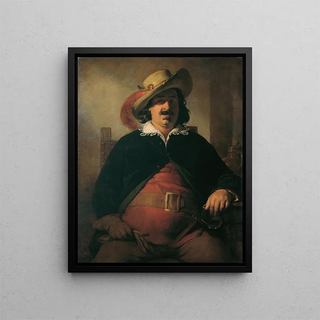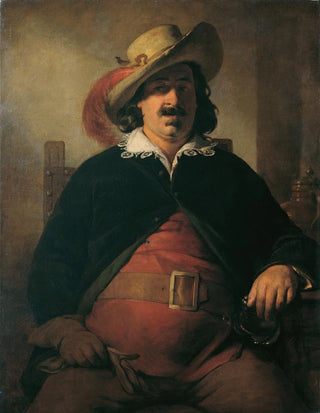Art print | The landscape painter Ignaz Raffalt as Falstaff - Friedrich von Amerling Source: Reproduction | Le peintre paysagiste Ignaz Raffalt dans le rôle de Falstaff - Friedrich von Amerling


View from behind

Frame (optional)
In the world of art, some works transcend the simple canvas to become windows into bygone eras, tangible emotions, and stories forever etched into collective memory. The art print of the landscape painter Ignaz Raffalt in the role of Falstaff - Friedrich von Amerling is a perfect example. This piece, blending realism and poetry, immerses us in a universe where the character of Falstaff, emblematic of Shakespearean comedy, resonates with both playful and profound echoes. Through the painter's gaze, the artist does not merely depict a character; he evokes an atmosphere, a moment suspended between laughter and melancholy.
Style and uniqueness of the work
Friedrich von Amerling, master of portrait and landscape, deploys in this art print a palette of delicate colors and subtle light that envelop the viewer. The choice to depict Ignaz Raffalt, a landscape painter of his time, in the role of Falstaff, is a bold move that highlights the artist's singularity. Amerling does not limit himself to simple imitation of reality; he infuses his piece with a narrative dimension that captures the very essence of the character. The contrast between Falstaff's flamboyant costume and the natural setting surrounding him creates a fascinating visual tension. The meticulous details, from the folds of the clothing to facial expressions, add psychological depth to the work, making the character both lively and timeless.
The artist and his influence
Friedrich von Amerling, born in 1803 in Vienna, is an essential figure of the 19th-century artistic movement. His work is marked by a particular attention to detail and a capacity to capture the psychology of his subjects. Influenced by Romanticism, Amerling knew how to combine tradition and innovation, standing out for his ability to paint portraits that go beyond mere representation. His approach to landscape, often integrated into his portraits, demonstrates a deep respect for nature and a desire to incorporate it into storytelling. By choosing to portray Ignaz Raffalt in the role of Falstaff, Amerling pays homage to none

Matte finish

View from behind

Frame (optional)
In the world of art, some works transcend the simple canvas to become windows into bygone eras, tangible emotions, and stories forever etched into collective memory. The art print of the landscape painter Ignaz Raffalt in the role of Falstaff - Friedrich von Amerling is a perfect example. This piece, blending realism and poetry, immerses us in a universe where the character of Falstaff, emblematic of Shakespearean comedy, resonates with both playful and profound echoes. Through the painter's gaze, the artist does not merely depict a character; he evokes an atmosphere, a moment suspended between laughter and melancholy.
Style and uniqueness of the work
Friedrich von Amerling, master of portrait and landscape, deploys in this art print a palette of delicate colors and subtle light that envelop the viewer. The choice to depict Ignaz Raffalt, a landscape painter of his time, in the role of Falstaff, is a bold move that highlights the artist's singularity. Amerling does not limit himself to simple imitation of reality; he infuses his piece with a narrative dimension that captures the very essence of the character. The contrast between Falstaff's flamboyant costume and the natural setting surrounding him creates a fascinating visual tension. The meticulous details, from the folds of the clothing to facial expressions, add psychological depth to the work, making the character both lively and timeless.
The artist and his influence
Friedrich von Amerling, born in 1803 in Vienna, is an essential figure of the 19th-century artistic movement. His work is marked by a particular attention to detail and a capacity to capture the psychology of his subjects. Influenced by Romanticism, Amerling knew how to combine tradition and innovation, standing out for his ability to paint portraits that go beyond mere representation. His approach to landscape, often integrated into his portraits, demonstrates a deep respect for nature and a desire to incorporate it into storytelling. By choosing to portray Ignaz Raffalt in the role of Falstaff, Amerling pays homage to none






